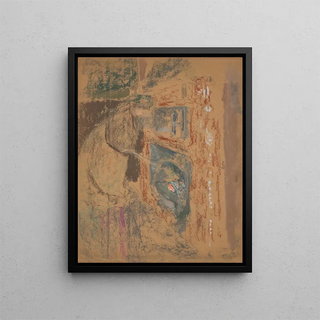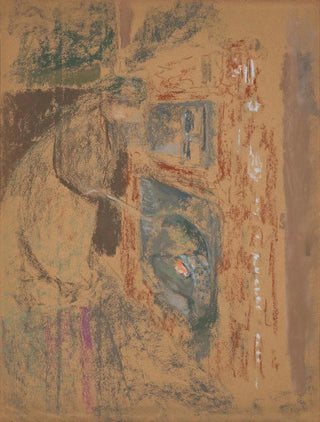Art print | Madame Vuillard devant la cheminée - Édouard Vuillard


View from behind

Frame (optional)
In the world of art, some works manage to capture the essence of a moment, an atmosphere, an emotion. "Madame Vuillard devant la cheminée" by Édouard Vuillard is one of these creations. Painted at the end of the 19th century, this canvas evokes a warm and intimate interior, where light plays a central role. The scene depicts a woman, probably the artist's mother, lost in her thoughts, absorbed by the warmth of the hearth. The piece invites the viewer to enter a universe where everyday life transforms into poetry, revealing the sensitivity and delicacy that characterize Vuillard's work.
Style and uniqueness of the work
Vuillard's style is marked by an intimate impressionism, distinguished by the use of soft colors and delicate patterns. In "Madame Vuillard devant la cheminée," the artist deploys a palette of warm tones, blending shades of brown, gold, and red, which evoke the warmth of the fireplace. The details of the scene, such as the textures of fabrics and the play of light, are rendered with remarkable finesse. The work is also characterized by a carefully balanced composition, where the figure of the woman is both the focal point and an integral part of the environment. This dialogue between the subject and its setting creates an atmosphere of serenity and contemplation, allowing the viewer to feel the intimacy of this shared moment.
The artist and his influence
Édouard Vuillard, a member of the Nabi movement, played a crucial role in the evolution of modern art. His ability to capture human emotions and domestic atmospheres influenced many artists throughout the 20th century. Vuillard stands out for his pursuit of harmony between the individual and their environment, a concern that still resonates today. His innovative approach to color and form paved the way for new explorations in the field of painting. By focusing on everyday subjects, he was able to give emotional depth to seemingly banal scenes, thus transforming the perception of domestic life into art. "Madame Vuillard devant la cheminée" is an example

Matte finish

View from behind

Frame (optional)
In the world of art, some works manage to capture the essence of a moment, an atmosphere, an emotion. "Madame Vuillard devant la cheminée" by Édouard Vuillard is one of these creations. Painted at the end of the 19th century, this canvas evokes a warm and intimate interior, where light plays a central role. The scene depicts a woman, probably the artist's mother, lost in her thoughts, absorbed by the warmth of the hearth. The piece invites the viewer to enter a universe where everyday life transforms into poetry, revealing the sensitivity and delicacy that characterize Vuillard's work.
Style and uniqueness of the work
Vuillard's style is marked by an intimate impressionism, distinguished by the use of soft colors and delicate patterns. In "Madame Vuillard devant la cheminée," the artist deploys a palette of warm tones, blending shades of brown, gold, and red, which evoke the warmth of the fireplace. The details of the scene, such as the textures of fabrics and the play of light, are rendered with remarkable finesse. The work is also characterized by a carefully balanced composition, where the figure of the woman is both the focal point and an integral part of the environment. This dialogue between the subject and its setting creates an atmosphere of serenity and contemplation, allowing the viewer to feel the intimacy of this shared moment.
The artist and his influence
Édouard Vuillard, a member of the Nabi movement, played a crucial role in the evolution of modern art. His ability to capture human emotions and domestic atmospheres influenced many artists throughout the 20th century. Vuillard stands out for his pursuit of harmony between the individual and their environment, a concern that still resonates today. His innovative approach to color and form paved the way for new explorations in the field of painting. By focusing on everyday subjects, he was able to give emotional depth to seemingly banal scenes, thus transforming the perception of domestic life into art. "Madame Vuillard devant la cheminée" is an example






